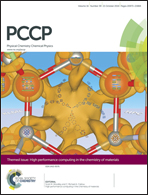Cross-polarization for dissolution dynamic nuclear polarization
Abstract
Dynamic nuclear polarization (DNP) in combination with subsequent dissolution of the sample allows the detection of low-γ nuclei in the solution state with a signal gain of up to tens of thousand times compared to experiments starting from Boltzmann conditions. The long polarization build-up times of typically more than one hour are a drawback of this technique. The combination of dissolution DNP with cross-polarization (CP) in the solid state was shown to have the potential to overcome this disadvantage. In this article we discuss the cross-polarization step under dissolution DNP conditions in more detail. We show that adiabatic half-passage pulses allow us to enhance the CP efficiency in power-limited DNP probes. As a low-power alternative to Hartmann–Hahn CP we also demonstrate the applicability of frequency-swept de- and re-magnetization pulses for polarization transfer via dipolar order. We investigate the implications and restrictions of the common solid-state DNP mechanisms to the DNP–CP technique and apply a spin-thermodynamic model based on the thermal-mixing mechanism. The model allows us to investigate the dynamics of the polarization levels in a system with two nuclear Zeeman reservoirs and explains the enhanced DNP efficiency upon solvent deuteration within a spin-thermodynamic picture.



 Please wait while we load your content...
Please wait while we load your content...